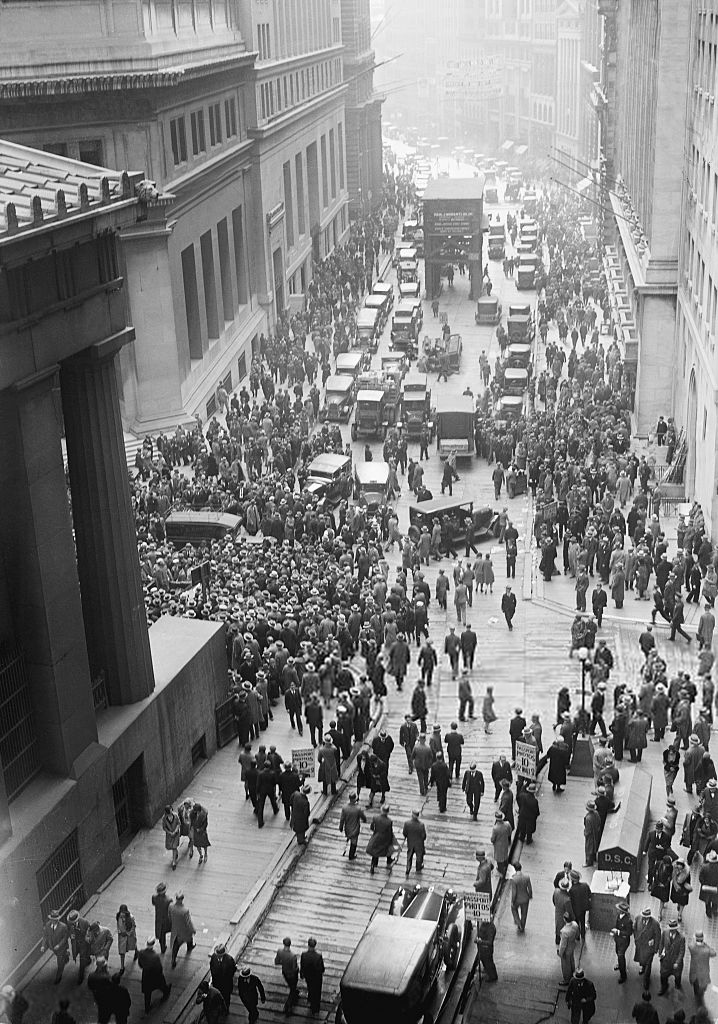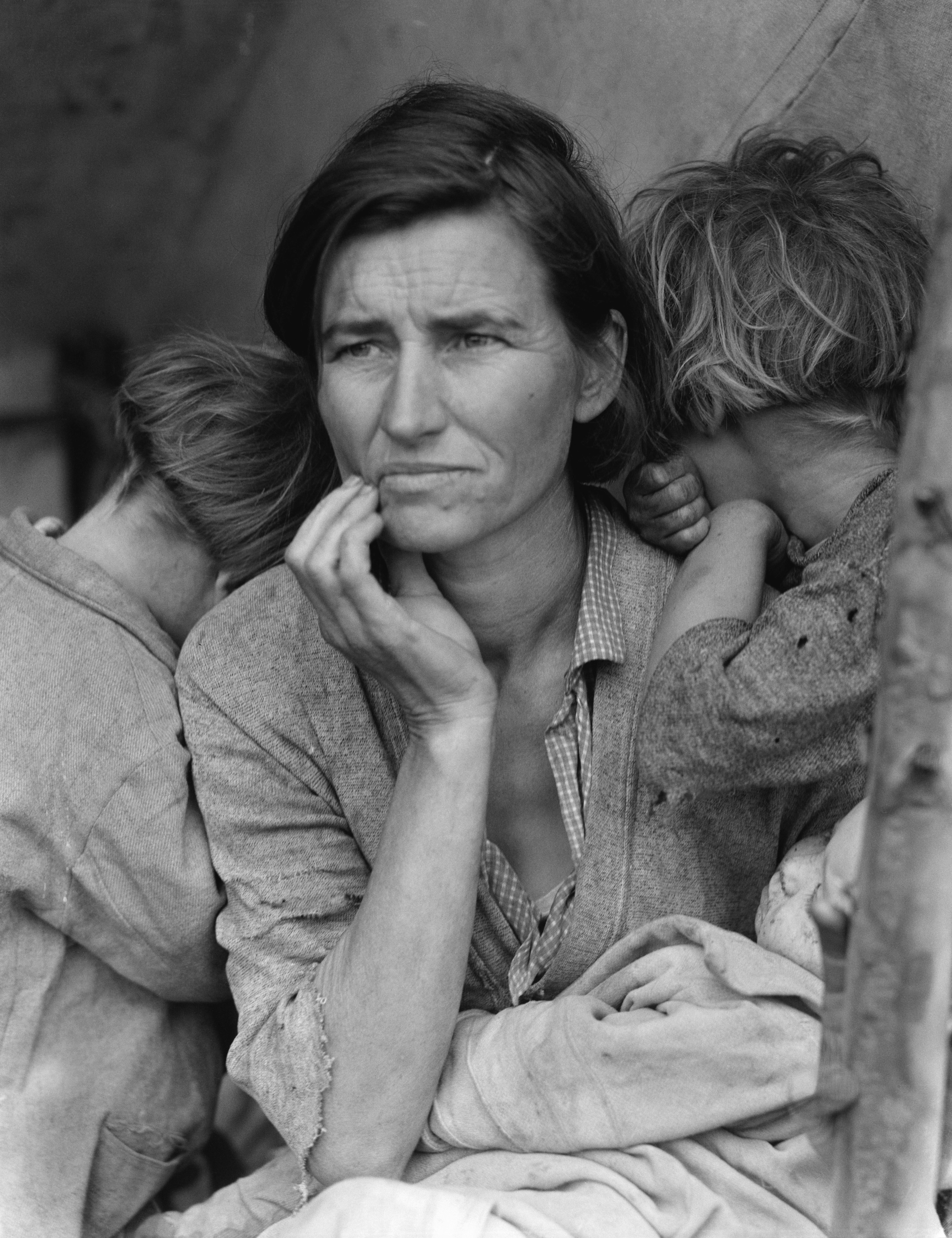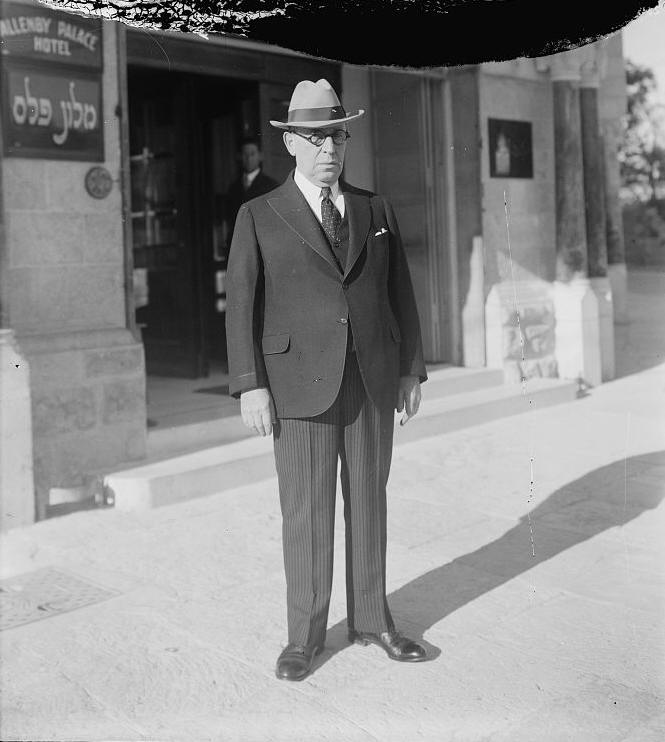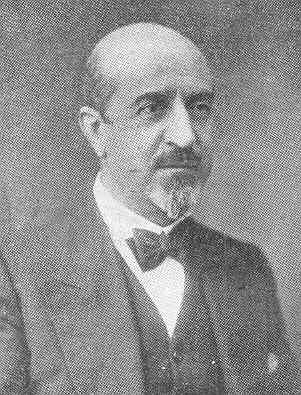|
1929
This year marked the end of a period known in American history as the Roaring Twenties after the Wall Street Crash of 1929 ushered in a worldwide Great Depression. In the Americas, an agreement was brokered to end the Cristero War, a Catholic counter-revolution in Mexico. The Judicial Committee of the Privy Council, a British high court, ruled that Canadian women are persons in the '' Edwards v. Canada (Attorney General)'' case. The 1st Academy Awards for film were held in Los Angeles, while the Museum of Modern Art opened in New York City. The Peruvian Air Force was created. In Asia, the Republic of China and the Soviet Union engaged in a minor conflict after the Chinese seized full control of the Manchurian Chinese Eastern Railway, which ended with a resumption of joint administration. In the Soviet Union, General Secretary Joseph Stalin expelled Leon Trotsky and adopted a policy of collectivization. The Grand Trunk Express began service in India. Rioting between Mus ... [...More Info...] [...Related Items...] OR: [Wikipedia] [Google] [Baidu] |
Afghan Civil War (1928–1929)
The Afghan Civil War was fought from 14 November 1928 to 13 October 1929. Rebelling, and subsequently governing Saqqawist (''Saqāwīhā'') forces under Habibullāh Kalakāni fought against various opposing tribes and rival monarchs in the Kingdom of Afghanistan, among whom Mohammed Nādir Khān eventually achieved a preponderant role. Despite early successes, such as the capture of Kabul and defeat of Amanullah Khan on 17 January 1929 or the capture of Kandahar on 3 June, the Saqqawists were eventually deposed by anti-Saqqawist forces led by Nadir on 13 October 1929, leading to Nadir's ascension as King of Afghanistan, who ruled until his assassination on 3 November 1933. The war began when the Shinwari tribe revolted in Jalalabad and drew a manifesto of 10 grievances, 5 of which related to Amanullah's meddling with the status of women. Although this revolt was quelled by a force led by Ali Ahmad Khan, a concurrent Saqqawist uprising in the north managed to capture the besiege ... [...More Info...] [...Related Items...] OR: [Wikipedia] [Google] [Baidu] |
Wall Street Crash Of 1929
The Wall Street Crash of 1929, also known as the Great Crash, was a major American stock market crash that occurred in the autumn of 1929. It started in September and ended late in October, when share prices on the New York Stock Exchange collapsed. It was the most devastating stock market crash in the history of the United States, when taking into consideration the full extent and duration of its aftereffects. The Great Crash is mostly associated with October 24, 1929, called ''Black Thursday'', the day of the largest sell-off of shares in U.S. history, and October 29, 1929, called ''Black Tuesday'', when investors traded some 16 million shares on the New York Stock Exchange in a single day. The crash, which followed the London Stock Exchange's crash of September, signaled the beginning of the Great Depression. Background The " Roaring Twenties", the decade following World War I that led to the crash, was a time of wealth and excess. Building on post-war optimism, rural Am ... [...More Info...] [...Related Items...] OR: [Wikipedia] [Google] [Baidu] |
1929 Hebron Massacre
The Hebron massacre refers to the killing of sixty-seven or sixty-nine Jews on 24 August 1929 in Hebron, then part of Mandatory Palestine, by Arabs incited to violence by rumors that Jews were planning to seize control of the Temple Mount in Jerusalem. The event also left scores seriously wounded or maimed. Jewish homes were pillaged and synagogues were ransacked. Some of the 435 Jews who survived were hidden by local Arab families, although the extent of this phenomenon is debated. Soon after, all Hebron's Jews were evacuated by the British authorities.Troops Seize Arab Chiefs at Gates of Jerusalem , ''The New York Times'', August 30, 1929 Many returned in 1931, but almost all were evacuated at the outbreak of the [...More Info...] [...Related Items...] OR: [Wikipedia] [Google] [Baidu] |
Great Depression
The Great Depression (19291939) was an economic shock that impacted most countries across the world. It was a period of economic depression that became evident after a major fall in stock prices in the United States. The economic contagion began around September and led to the Wall Street stock market crash of October 24 (Black Thursday). It was the longest, deepest, and most widespread depression of the 20th century. Between 1929 and 1932, worldwide gross domestic product (GDP) fell by an estimated 15%. By comparison, worldwide GDP fell by less than 1% from 2008 to 2009 during the Great Recession. Some economies started to recover by the mid-1930s. However, in many countries, the negative effects of the Great Depression lasted until the beginning of World War II. Devastating effects were seen in both rich and poor countries with falling personal income, prices, tax revenues, and profits. International trade fell by more than 50%, unemployment in the U.S. rose to 23% ... [...More Info...] [...Related Items...] OR: [Wikipedia] [Google] [Baidu] |
1929 Palestine Riots
The 1929 Palestine riots, Buraq Uprising ( ar, ثورة البراق, ) or the Events of 1929 ( he, מאורעות תרפ"ט, , ''lit.'' Events of 5689 Anno Mundi), was a series of demonstrations and riots in late August 1929 in which a longstanding dispute between Muslims and Jews over access to the Western Wall in Jerusalem escalated into violence. The riots took the form, for the most part, of attacks by Arabs on Jews accompanied by destruction of Jewish property. During the week of riots, from 23 to 29 August, 133 Jews were killed by Arabs, and 339 Jews were injured, most of whom were unarmed. There were 116 Arabs killed and at least 232 wounded, mostly by the Mandate police suppressing the riots. Around 20 Arabs were killed by Jewish attackers and indiscriminate British gunfire. After the riots, 174 Arabs and 109 Jews were charged with murder or attempted murder; around 40% of Arabs and 3% of Jews were subsequently convicted. During the riots, 17 Jewish communities were e ... [...More Info...] [...Related Items...] OR: [Wikipedia] [Google] [Baidu] |
Centenary Of Western Australia
In 1929, Western Australia (WA) celebrated the centenary of the founding of Perth and the establishment of the Swan River Colony, the first permanent European settlement in WA. A variety of events were run in Perth, regional areas throughout the state, and even across Australia such as the Western Australian Centenary Air Race. Preparations In 1926, the 25th anniversary of federation passed without much recognition, due in part to the sense of isolation that help to form Western Australia's identity. There was limited acknowledgement from the other states of the unique circumstances of Western Australia's situation, due to what historian Geoffrey Blainey described as "the tyranny of distance". It was this isolation that helped focus the community on celebrating its centenary; later, it would also be the catalyst for a growing secessionist movement. In 1927, the premier, Philip Collier, asked Hal Colebatch to write a history of the state, and in 1929 ''A Story of a hundred year ... [...More Info...] [...Related Items...] OR: [Wikipedia] [Google] [Baidu] |
Sino-Soviet Conflict (1929)
The Sino-Soviet conflict of 1929 (, russian: Конфликт на Китайско-Восточной железной дороге) was an armed conflict between the Union of Soviet Socialist Republics and Chinese warlord Zhang Xueliang of the Republic of China over the Chinese Eastern Railway (also known as CER). The conflict was the first major combat test of the reformed Soviet Red Army – one organized along the latest professional lines – and ended with the mobilization and deployment of 156,000 troops to the Manchurian border. Combining the active-duty strength of the Red Army and border guards with the call-up of the Far East reserves, approximately one-in-five Soviet soldiers was sent to the frontier, the largest Red Army combat force fielded between the Russian Civil War (1917–1922) and the Soviet Union's entry into the Second World War.Michael M. Walker, ''The 1929 Sino-Soviet War: The War Nobody Knew'' (Lawrence: University Press of Kansas, 2017), p. 1. In ... [...More Info...] [...Related Items...] OR: [Wikipedia] [Google] [Baidu] |
Roaring Twenties
The Roaring Twenties, sometimes stylized as Roaring '20s, refers to the 1920s decade in music and fashion, as it happened in Western society and Western culture. It was a period of economic prosperity with a distinctive cultural edge in the United States and Europe, particularly in major cities such as Berlin, Buenos Aires, Chicago, London, Los Angeles, Mexico City, New York City, Paris, and Sydney. In France, the decade was known as the '' années folles'' ("crazy years"), emphasizing the era's social, artistic and cultural dynamism. Jazz blossomed, the flapper redefined the modern look for British and American women, and Art Deco peaked. In the wake of the military mobilization of World War I and the Spanish flu, President Warren G. Harding " brought back normalcy" to the United States. The social and cultural features known as the Roaring Twenties began in leading metropolitan centres and spread widely in the aftermath of World War I. The spirit of the Roaring Twenties ... [...More Info...] [...Related Items...] OR: [Wikipedia] [Google] [Baidu] |
Lateran Treaty
The Lateran Treaty ( it, Patti Lateranensi; la, Pacta Lateranensia) was one component of the Lateran Pacts of 1929, agreements between the Kingdom of Italy under King Victor Emmanuel III of Italy and the Holy See under Pope Pius XI to settle the long-standing Roman Question. The treaty and associated pacts were named after the Lateran Palace where they were signed on 11 February 1929, and the Italian parliament ratified them on 7 June 1929. The treaty recognized Vatican City as an independent state under the sovereignty of the Holy See. The Italian government also agreed to give the Roman Catholic Church financial compensation for the loss of the Papal States. In 1948, the Lateran Treaty was recognized in the Constitution of Italy as regulating the relations between the state and the Catholic Church. Constitution of Italy, article 7. The treaty was significantly revised in 1984, ending the status of Catholicism as the sole state religion. Content The Lateran Pacts are ofte ... [...More Info...] [...Related Items...] OR: [Wikipedia] [Google] [Baidu] |
LZ 127 Graf Zeppelin
LZ 127 ''Graf Zeppelin'' () was a German passenger-carrying, hydrogen-filled rigid airship that flew from 1928 to 1937. It offered the first commercial transatlantic passenger flight service. Named after the German airship pioneer Ferdinand von Zeppelin, a count () in the German nobility, it was conceived and operated by Dr. Hugo Eckener, the chairman of Luftschiffbau Zeppelin. ''Graf Zeppelin'' made 590 flights totalling almost 1.7 million kilometres (over 1 million miles). It was operated by a crew of 36, and could carry 24 passengers. It was the longest and largest airship in the world when it was built. It made the first circumnavigation of the world by airship, and the first nonstop crossing of the Pacific Ocean by air; its range was enhanced by its use of Blau gas as a fuel. It was built using funds raised by public subscription and from the German government, and its operating costs were offset by the sale of special postage stamps to collectors, the support o ... [...More Info...] [...Related Items...] OR: [Wikipedia] [Google] [Baidu] |
Cristero War
The Cristero War ( es, Guerra Cristera), also known as the Cristero Rebellion or es, La Cristiada, label=none, italics=no , was a widespread struggle in central and western Mexico from 1 August 1926 to 21 June 1929 in response to the implementation of secularist and anticlerical articles of the 1917 Constitution. The rebellion was instigated as a response to an executive decree by Mexican President Plutarco Elías Calles to strictly enforce Article 130 of the Constitution, a decision known as Calles Law. Calles sought to eliminate the power of the Catholic Church in Mexico, its affiliated organizations and to suppress popular religiosity. The rural uprising in north-central Mexico was tacitly supported by the Church hierarchy, and was aided by urban Catholic supporters. The Mexican Army received support from the United States. American Ambassador Dwight Morrow brokered negotiations between the Calles government and the Church. The government made some concessions, the Church wit ... [...More Info...] [...Related Items...] OR: [Wikipedia] [Google] [Baidu] |
1st Academy Awards
The 1st Academy Awards ceremony, presented by the Academy of Motion Picture Arts and Sciences (AMPAS) and hosted by AMPAS president Douglas Fairbanks, honored the best films from 1 August 1927 to 31 July 1928 and took place on May 16, 1929, at a private dinner held at the Hollywood Roosevelt Hotel in Los Angeles, California. Tickets cost $5 ($ in , considering inflation); 270 people attended the event, which lasted 15 minutes. It is the only Academy Awards ceremony not broadcast on either radio or television; a radio broadcast was introduced for the 2nd Academy Awards. During the ceremony, AMPAS presented Academy Awards later to be colloquially known as "Oscars" in 12 categories. The winners had been announced three months ahead of the ceremony. Some nominations did not reference a specific film, such as Ralph Hammeras and Nugent Slaughter, who were nominated for Engineering Effects, a category that was dropped the following year (along with ... [...More Info...] [...Related Items...] OR: [Wikipedia] [Google] [Baidu] |








